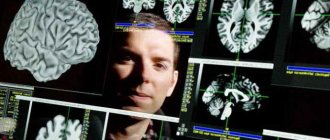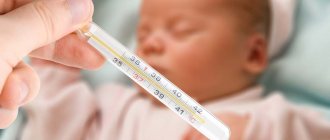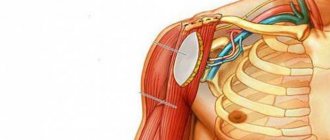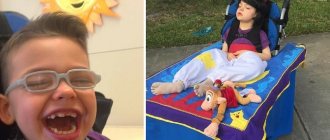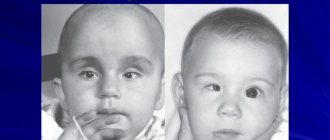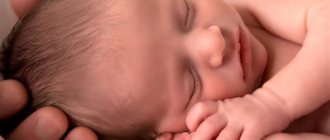Muscle tone disorders in newborns are a large group of movement disorders that appear from the moment of birth and are characterized by changes in the degree of muscle tension. There is increased and decreased muscle tone, as well as dystonia, which is an alternation of hypertonicity and hypotonicity. Movement disorders are manifested by either excessive muscle tension or inadequate relaxation. Both options are accompanied by difficulties associated with feeding the baby, poor sleep, anxiety, etc. The pathology is diagnosed clinically, based on laboratory and X-ray examination data. Treatment tactics are determined by the underlying disease and may include conservative (dehydration therapy, antibiotic therapy, muscle relaxants) and surgical treatment measures.
Helpful information
Do your joints hurt?
Movement disorder syndrome in newborns
Motor disturbance syndrome is one of the consequences of perinatal damage to the central nervous system during the period from 26 (28) weeks of pregnancy to 7 days after birth.
The causes of perinatal damage to the central nervous system can consist of a state of hypoxia as a result of hemolytic disease of the newborn, for example, due to Rhesus conflict, intrauterine infection, disruption of the utero-placental - fetal blood flow. Movement disorder syndrome in children may be the result of obstetric trauma. Movement disorder syndrome is often accompanied by a child’s mental or physical developmental delay, for example, slowing or impaired articulation and facial expressions. Movement disorder syndrome in the newborn occurs in 5% of children. The main risk groups are: borderline age of the mother (under 18 and over 35 years), pathology of the placenta (premature abruption, placenta previa), rapid or long labor, bad habits of the mother during pregnancy and breastfeeding. Diabetes mellitus in the mother during pregnancy, multiple births and polyhydramnios, taking medications that have a direct or indirect effect on the fetus.
Motor impairment syndrome can occur in children who are on mechanical ventilation for a long time or have damage to the respiratory center.
Movement disorder syndrome in newborns: signs
Movement disorder syndrome in children has the following symptoms: as a rule, it is detected from the first weeks or even days of a child’s life and proceeds along 2 main paths.
The first way is the formation of motor disorders with a predominance of muscle hypnosis of the flexors and extensors of the limbs, convulsive readiness, increased tendon reflexes, as well as the possible appearance of pathological reflexes or long-term preservation of unconditioned reflexes. Tremors (shaking) of the arms, legs and chin may occur when crying, or the baby may scream. The second way is muscle hypotonia with the development of muscle flaccidity, decreased tone, inhibition of tendon reflexes and spontaneous motor activity. It can be combined with difficulty in speech and mental development, poor facial expressions and articulation, late appearance of a smile, delayed visual-auditory reactions and a weak monotonous cry.
Parents should monitor such babies very carefully and be sure to consult a neurologist.
Movement disorder syndrome in infants: treatment
Movement disorders syndrome: treatment includes mandatory observation by a neurologist with the prescription of basic medications (Vit E, nootropics, etc.). Mandatory in the treatment of movement disorder syndrome in a newborn is the prescription of physiotherapy methods in the correction of basic movement disorders.
Rehabilitation of children should begin immediately after diagnosis. Movement disorder syndrome: treatment should include a comprehensive prescription of medications, physiotherapy, and massage. You can get help in providing modern methods of physical therapy at Belozerova’s hardware therapy clinic “M-Clinic”. Massage is also very important in the treatment of the consequences of perinatal damage to the central nervous system. It can be both relaxing and tonic, depending on the predominance of the first or second variant of the disease.
Correcting a child with this syndrome is also important in terms of the child’s social adaptation in society, because difficulties in pronouncing words and poor emotions create great difficulties in everyday life.
Our specialists treat all of the listed diseases using proprietary methods; do not deny yourself the opportunity to be healthy.
Our clinic uses only advanced equipment and innovative treatment methods
Movement disorder syndrome (MDS) is a human movement disorder caused by brain damage and disruption of the central nervous system. It usually affects one or more parts of the brain: the cerebral cortex, subcortical nuclei, brainstem. The form of muscle pathology is determined by the volume and area of brain damage. The disease is manifested by pathological changes in muscle tone and various motor disorders.
The disease develops in infants 2-4 months old who have suffered trauma or brain hypoxia. The causes of movement disorder syndrome in children may be negative factors that have an intrauterine effect on the fetus and cause perinatal damage to the central nervous system. Convulsive muscle activity, hypotension and weakness require urgent treatment.
SDN clinically manifests itself already in the first days and weeks of a child’s life. In sick children, hypo- or hypertonicity of muscles occurs, spontaneous motor activity decreases or increases, motor function of the limbs is weakened, and reflex activity is disrupted. They lag behind their peers in physical development, cannot cope with purposeful movements and their coordination, and have difficulties with hearing, vision and speech. The development of muscle tissue in different limbs occurs at different rates.
These problems gradually provoke mental development disorders and intellectual inferiority. Speech and psycho-emotional development slows down. Children with SDN begin to sit, crawl and walk somewhat later than their peers. Some of them cannot hold their heads up even at one year old. The complete absence of voluntary movements of the laryngeal muscles in children leads to a violation of the swallowing reflex. This sign indicates a serious stage of the pathology, which requires urgent therapeutic measures that can eliminate such dangerous symptoms.
Since the syndrome does not progress, its timely and correct treatment produces impressive results. According to ICD-10, it is coded G25 and belongs to “Other extrapyramidal and movement disorders.”
Causes
Motor disorders in newborns are always associated with dysfunction at the level of the central nervous system (brain and spinal cord), or at the level of peripheral nerves going directly to the muscles. As a rule, damage to brain cells occurs in utero or during childbirth. The nature of such damage can be traumatic, hypoxic or infectious. As a result of damage, some neurons die or begin to function incorrectly. In addition, many injuries lead to increased intracranial pressure, as a result of which hypertonicity is often observed.
There are also hereditary and congenital neurological diseases, in the clinic of which there are not only muscle tone disorders in newborns, but also other manifestations. There may be abnormalities in the development of the nervous system, which are formed, among other things, under the influence of teratogenic factors during pregnancy, for example, smoking or drinking alcohol. The mother's chronic diseases, in particular diabetes, play a certain role. In pediatrics, one of the most serious diagnoses, in the clinic of which disorders of muscle tone in newborns are always present, is cerebral palsy.
Symptoms
Changes in the normal structure of the brain are manifested by various motor disorders. This is due to a disruption in the transmission of nerve impulses from brain structures to skeletal muscles and the development of a pathological condition in these muscle groups.
Clinical signs of movement disorder syndrome in infants:
- Decreased muscle strength, slow baby movements.
- Muscle hypotonia leads to dystrophic processes and thinning of the limbs.
- Weakening or strengthening of tendon reflexes.
- Paralysis and paresis.
- Muscle overstrain, spasms, cramps.
- Involuntary movements.
- Violation of basic reflexes - grasping and sucking.
- Inability to independently hold the head, lift and bend limbs, roll over, bend fingers.
- Monotonous screaming and crying.
- Articulation impairment.
- Poor facial expressions of the patient, lack of smiles.
- Delayed visual and auditory reactions.
- Difficulty breastfeeding.
- Convulsive syndrome, bluish skin.
Infants with SDN sleep poorly, stare at one point for a long time, and periodically shudder convulsively. They can only turn their head and spread their legs with outside help. Patients press one arm tightly to the body. With their other hand they move and pick up the rattle. Complete relaxation is often replaced by body tension. If there are visual dysfunctions, the baby does not reach the right thing on the first try.
Symptoms of hypertension:
- the baby's body bends in an arched manner,
- the baby begins to hold his head up early, pick up toys,
- a sick child presses his clenched fists to his body,
- head turned to one side
- The baby stands on his toes, and not on his entire foot.
Symptoms of hypotension:
- sick baby is lethargic,
- he doesn't move his limbs much,
- cannot hold a toy in his hand,
- screams weakly
- the child throws his head back and cannot hold it for a long time,
- does not begin to crawl, sit and stand up in time,
- does not maintain balance in a sitting position, staggers from side to side.
There are several forms of pathology:
- with predominant damage to the legs - the child moves his arms, “drags” his legs, begins to walk late;
- unilateral damage to the muscles of the entire body with impaired swallowing and speech function, mental retardation;
- disorder of motor functions due to damage to both limbs - inability to crawl, stand and walk;
- complete immobility of the child, mental retardation, mental instability.
If a child has been diagnosed with SDN, it is necessary to act and not despair. When provided with qualified medical care, a child’s body can resist the disease. It happens that neurologists make mistakes or make a similar diagnosis, playing it safe, especially if the symptoms are subtle. As a result of careful observation of such children, the diagnosis is removed. The child grows up completely healthy.
Stages of development of movement disorder syndrome:
- The early stage is manifested by impaired muscle tone. Babies 3-4 months old with SDN often do not turn their heads, and babies 5-6 months old do not reach for toys or suffer from seizures.
- The second stage manifests itself with more noticeable signs: patients cannot hold their head up for 10 months, but try to sit down, turn around, walk or stand in an unnatural position. At this time, uneven development of the child occurs.
- The late stage of the syndrome occurs after 3 years. This is an irreversible stage, characterized by skeletal deformation, the formation of joint contractures, problems with hearing, vision and swallowing, impaired speech and psychophysical development, and convulsions.
Normal stages of child development
Internal organs are involved in the pathological process, which is manifested by impaired excretion of urine and feces, disarticulation, and incoordination of movements. The syndrome is often combined with epilepsy, mental and mental development disorders. Sick children perceive information poorly and have difficulty eating and breathing. In the future, sick children have problems with learning. This is associated with impaired memory and ability to concentrate. Hyperactive children suffer from restlessness and lack interest in activities.
Timely contact with specialists helps to avoid serious consequences. Late detection of the syndrome complicates the situation. Normal children in the first or second year of life pronounce individual sounds, whole syllables and simple words, but children with SDN only produce incomprehensible whining. Heavy breathing is accompanied by uncontrolled opening of the mouth, a nasal tone of voice, and the pronunciation of inarticulate sounds. Disruption of the normal structure of the nervous tissue limits the child’s independence of free movement and only partially preserves the ability for self-care.
General information
Muscle tone disorders in newborns are a syndrome that accompanies many diseases, including congenital and hereditary ones. Movement disorders that appear from the moment of birth can persist throughout later life and cause mental and physical development delays, which, in turn, contributes to the growth of childhood disability. That is why timely diagnosis of muscle tone disorders in newborns and treatment of the underlying nosology is so important. At the same time, the prevention of such disorders plays an even more significant role, since the correct intrauterine development of the fetus largely depends on the characteristics of the mother’s body and her living conditions.
Diagnostics
The diagnosis and treatment of the syndrome is carried out by specialists in the field of neurology and pediatrics, who make their diagnosis based on data obtained from the history of pregnancy and childbirth of the mother. The results of laboratory tests, ultrasound, tomography and encephalography are of great importance.
- Perinatal history - intrauterine infection, severe intoxication of the body, oxygen starvation of the brain.
- Assessment of a newborn using the Apgar scale allows you to characterize the vitality of the baby at birth.
- Neurosonography is an examination of a newborn that involves scanning the brain with ultrasound.
- Ultrasound with Doppler - study of cerebral blood flow through the fontanel.
- Electroencephalography is a method for studying the electrical activity of the brain removed from the surface of the scalp, recording such potentials.
- Electroneuromyography is performed to assess muscle tone.
- A CT or MRI scan of the brain can detect lesions.
- Examination by an ophthalmologist, ENT specialist, psychiatrist, orthopedic traumatologist.
Treatment
A child with SDN should be observed by a neurologist and undergo comprehensive treatment. Currently, there are effective techniques that can quickly eliminate the disease. The earlier the syndrome is detected, the easier it is to fight it.
A set of therapeutic measures used for SDN:
- Massage is an effective tool that allows you to achieve excellent results. Before the session, the child is warmed up, and after it, he is wrapped in a woolen blanket. A massage therapist must specialize in working with newborns and infants. After 10-15 sessions, the patient’s condition improves significantly.
- Therapeutic exercise restores motor functions and coordination of movements.
- Osteopathy is an effect on certain points of the body.
- Reflexology is indicated for children with delays in maturation of the nervous system and development.
- Homeopathy activates brain processes.
- Physiotherapy - myostimulation for muscle hypotonia, paraffin therapy, hydromassage, baths, electrophoresis, magnetic therapy.
- Diet therapy - eating foods containing vitamin B.
- Balneotherapy, mud therapy, animal therapy - communication with dolphins and horses.
- Pedagogical correction, special regime and speech therapy techniques.
- Use of auxiliary devices - walkers, chairs, stand-up machines, bicycles, exercise equipment, pneumatic suits.
- Sanatorium and resort treatment in Crimea and on the Black Sea coast of the Krasnodar Territory.
Drug treatment consists of the use of anticonvulsants and muscle relaxants; diuretics; drugs that reduce intracranial pressure; B vitamins; drugs that improve microcirculation in brain tissue; antihypoxants; drugs that tonic blood vessels. Patients are prescribed Cerebrolysin, Cortexin, Ceraxon, Actovegin, Piracetam, Glycine, Neurovitan, Mydocalm, ATP, Proserin.
Surgery for hydrocephalus allows you to restore the outflow of cerebrospinal fluid. Surgeons perform tendon and muscle plastic surgery and remove contractures. In order to correct disorders in the nervous tissue, neurosurgical interventions are performed.
SDN responds well to treatment if it is started correctly and on time. The prognosis of the pathology largely depends on the observation of parents and the professionalism of doctors. If the syndrome is not treated, serious consequences of functional failure of the central nervous system may develop - cerebral palsy and epilepsy, which require longer and more severe therapy.
Video: example of massage for the treatment of SDN
Treatment of muscle tone disorders in newborns
Therapy for the syndrome is determined by the main diagnosis. Infectious diseases require the prescription of antibiotics and antiviral drugs. Dehydration therapy is indicated to normalize intracranial pressure. After confirming the diagnosis of a particular metabolic disease, specific therapy is carried out. In all cases, neuroprotectors are a mandatory part of treatment. To eliminate hypertension, muscle relaxants are used. Along with the symptomatic effect, drugs in this group make it possible to clarify the prognosis, since in the case of severe disorders of muscle tone in newborns, the drugs become ineffective. If abnormalities of the nervous system, tumors and other organic pathologies are detected, surgical treatment is indicated.
Prevention and prognosis
Preventive measures to avoid the development of the syndrome:
- protection of motherhood and childhood;
- eliminating bad habits in pregnant women;
- the child’s interest in learning about the world around him with the help of colorful pictures and bright toys;
- barefoot walking, exercise therapy, therapeutic massage, fitball exercises,
- frequent finger play, walking on textured surfaces.
SDD is a treatable disease that needs to be fought. A mild form of the pathology responds well to adequate therapy. More severe cases require a special approach. If parents do not notice dangerous symptoms and do not consult a doctor in time, the child will have difficulty walking and learning. Advanced forms are complicated by mental retardation and epilepsy. Any delay in treatment can turn a mild case into a complex process.
Movement disorder syndrome is a complex pathology of child development, which usually occurs during pregnancy or childbirth under the influence of various negative factors. These include cerebral hypoxia, birth injuries, prolonged uncontrolled gestosis, placental abruption, infections, poisoning of the baby in the womb with alcohol, nicotine, drugs and some medications. This syndrome is directly related to disruption of the baby’s nervous system, and it is usually detected in the first year of a child’s life. Let's talk about what it is - muscular dystonia and the diagnosis of SMD, and how to cope with them.
Causes of muscular dystonia syndrome
The most common cause of this disease is birth trauma or damage to the baby’s brain due to impaired blood circulation or oxygen deprivation during pregnancy or during labor (with ischemic or hypoxic encephalopathy). Dystonia occurs due to degenerative hereditary diseases or while taking certain medications. If the cause of the disease cannot be established, then a diagnosis of “idiopathic muscular dystonia” is made.
Muscular dystonia in children
Muscular dystonia is expressed in disorders of the child’s muscle tone, i.e. the baby may have stiffness in some parts of the body. In severe cases, the disease affects the entire body, and the baby is practically unable to move at all.
Muscular dystonia syndrome usually becomes noticeable even during the period when the baby is considered a newborn, i.e. in the first month of his life. There are quite obvious signs by which the disease can be identified:
- unnatural postures of the body or some of its parts (twisted arms, arched back, etc.);
- muscle hypertnus - they are very tense and prevent the baby from relaxing and making coordinated movements;
- muscle hypotonicity - high lethargy of the limbs, the body may look “limp”;
- a combination of hypo- and hypertonicity - some part of the baby’s body has increased muscle tone, and some has decreased;
- poor facial expressions;
- lack of a smile in a child older than three months;
- weak, monotonous cry.
With careful communication with the baby, it is quite possible to promptly detect the first inclinations of muscular dystonia syndrome in an infant. It is important for parents not to turn a blind eye to the problem, but at the slightest suspicion of deviations in the behavior and development of the child, contact a pediatrician and neurologist. Postponing a visit to these specialists can result in even more dire consequences:
- bone deformities;
- delayed physical development - the child learns to hold his head, back, sit, crawl, stand and walk far behind his peers. Moreover, he can perform these actions in a different sequence, which depends on the location of the violation;
- disability and partial loss of ability to perform normal work activities;
- inhibition of speech and visual-auditory development.
Muscular dystonia in newborns requires constant monitoring by a doctor, since the disease detected in time can be easily corrected, and your baby has every chance of a healthy and fulfilling life.
Treatment of muscular dystonia in children
Muscular dystonia syndrome is not a reason to give up, because with timely treatment, a child is able to level out developmental indicators and get closer to age norms. Of course, due to the seriousness of this pathology, it will take a lot of time to restore the baby, sometimes more than one year. This is why it is critical to start working on resolving the issue as early as possible.
To draw up a competent plan for the baby’s recovery, the doctor must have information about the causes of the disease, the severity of the disorders, the baby’s age and the time when the beginning abnormalities first appeared or were noticed. It is also important to know what form the disease takes and whether the baby has any associated health problems.
The prescription of specific medications is entirely individual and depends on the factors listed above. For severe hypotonicity, agents are used that can increase neuromuscular transmission, and for hypertonicity, on the contrary, lowering substances are used. In addition, homeopathic medicines and herbal treatments (herbal medicine) may be helpful.
In most cases, children with muscular dystonia are prescribed a course of massage and special exercises, including fitball exercises. An experienced massage therapist is able to work with a child in such a way that the first results will be noticeable after 15 sessions. Gymnastics on a fitball has a beneficial effect on the baby’s body, allowing you to relax some muscles and engage others.
Pool activities and physical therapy may also be included in the treatment plan. To improve the health of the child, the use of foods rich in B vitamins may be recommended. But the most important medicine is parental love and support. Thanks to them, the baby feels confident and comfortable, and his recovery proceeds more positively and safely. Try not to disturb the baby and not bring the situation to the point of crying. The fact is that in a state of excitement, muscle disorders can worsen, so protect your treasure from stress and mood swings. Caress and stroke the baby more often, carry him in your arms and talk to him. After all, everyone knows that parental love works wonders.
This is what I found:
Childhood movement disorder syndrome “Movement disorder syndrome” - this diagnosis should not frighten parents. The disease manifests itself already in the first months of a child’s life, as a violation (decrease or, conversely, increase) of muscle tone, the appearance of incomprehensible motor activity. Sometimes muscles develop with different intensity on different limbs - this is also a problem. Often this disease causes a slowdown in physical and mental development.
Why is this happening? Violations of tone prevent the child from developing correct motor functions, as a result of which the child begins to crawl and walk much later, and difficulties appear in mastering speech. With normal development, children already hold their heads at 3-4 months, but babies who are diagnosed with “motor impairment syndrome” cannot cope with this task even at 12 months. A specialist should notice the very first symptoms of abnormal development. And the sooner this happens, the better. It is important to detect the syndrome as early as possible
What should first alarm parents and force them to contact a specialist? These are disturbances in facial expressions, lack of a smile, weak (or absence) visual or auditory reactions. Read special literature for parents, communicate with experienced people, carefully monitor your child - this will help detect the disease as early as possible. If this was not possible and you discovered the disease quite late, for example at 7-9 months (8-10 months), then the situation becomes more complicated and you will need long-term and qualified help.
Well, this happened and you were diagnosed with “motor impairment syndrome” - you don’t need to get your hands dirty, you need to act. Each human body is individual and can withstand the disease with some success. We just need to help him. Moreover, the initial signs are so subtle that neurologists often make such a diagnosis “just in case” so as not to waste time. After some time, this diagnosis is removed and the child grows up completely healthy.
Even if everything is fine with you, but you are prudent and want to avoid problems: schedule regular visits to a specialist, approximately once a month. After a year, visits may become less frequent, for example, once every 3 months. It is better to prevent a problem than to fight it. The main thing is that the doctor notices the symptoms of the disease in time and recommends the correct treatment. How is movement disorder syndrome treated?
Treatment also depends on the level of intensity of the syndrome. If motor activity is reduced, drugs that stimulate neuromuscular connections are prescribed; in case of increased activity, on the contrary, drugs that reduce such connections are prescribed. Particular attention is paid to nutrition: you need to give foods rich in vitamin B.
Another effective remedy is massage - it allows you to achieve excellent results when used correctly. But the newborn’s body is still weak and it is important to find a person who specializes in infant massage, newborn massage. You need at least 10-15 massage sessions for changes for the better to appear. Before the massage, you should warm the child, especially the limbs, and after the exercise it is better to wrap them in soft woolen fabric or small felt boots for a while. Therapeutic exercise – how to do it?
First of all, consult a specialist - he will tell you the necessary exercises, taking into account the specifics of your child. As general advice, we can recommend frequent repetition of different movements in order to develop a motor stereotype. Learn several new movements with your arms and legs, repeat each about 30 times. The child should not lie down and calmly watch what is happening around. Try to somehow attract his attention, make him stretch. Stimulate your baby's motor activity.
Keep in mind that movement disorder syndrome in children is treatable, especially if it is started in a timely manner. Early treatment can help in quite complex cases, and, conversely, delay in treatment can turn a mild case into a complex one.
Brr... let her be safe.....
What diagnosis do you think is considered in the public consciousness almost a death sentence, which a priori makes treatment meaningless and the patient’s fate sad and tragic? Various problems with the cardiovascular system? Oncological diseases? “Incurable” hereditary pathologies? Hardly. Such ailments, of course, can ruin the life of even the most persistent and self-confident person, but with the appropriate approach and competent treatment, the problem can be dealt with one way or another (we especially note that in this case no one is talking about a complete recovery). But when cerebral palsy is detected in newborn children or infants, the world around the parents suddenly collapses to the size of a doctor’s office, who in a professional, absent voice conveys a terrible diagnosis. How does movement disorder syndrome relate to cerebral palsy, you ask? That's the point, no!
Cerebral palsy, if we discard the terminology that is complex and difficult to understand for the average person, is a complex of motor disorders caused by organic damage to the brain during fetal development. The movement disorder syndrome that we will talk about today is a much more multifaceted phenomenon. Domestic neonatologists and pediatricians tend to see its signs in any more or less noticeable deviation from abstract norms adopted back in the days of developed socialism. We will not discuss the reasons for this approach now, but we consider it our duty to once again remind you that movement disorder syndrome and cerebral palsy are (attention!) not the same thing.
Remember the characteristic passage from Sir William Shakespeare's play King Richard III, in which one of King Edward IV's brothers described his physical condition:
“I, who have neither height nor posture,
To whom is nature a fraud?
In return, she gave lameness and lopsidedness”?
Many particularly “advanced” pediatricians, when faced with characteristic clinical manifestations, make a diagnosis of “cerebral palsy”. This actually condemns children (most often newborns) to complete disability. Parents will be told that in this case they cannot count on any effective treatment, and massage, physical therapy sessions and various physiotherapeutic procedures can only slightly improve the baby’s condition. And, casually, they will recommend sending the baby to a special institution.
Movement Disorder Syndrome (hereinafter referred to as MDS for simplicity) is not a death sentence. Consequently, with adequate treatment, children most often make a full recovery. They may need regular massage sessions, observation by a neurologist, and slight limitation of physical activity in the future. But this, you see, is not at all the same as cerebral palsy. And if the parents don’t give up, everything will be fine for the child.
Types of muscular dystonia syndrome
Muscular dystonia syndrome is accompanied by minor deviations or excessive stiffness of individual parts of the body and limited motor activity, uneven or variable tone is noted. Specialists can determine hypertonicity, which is characterized by increased muscle tension, or hypotonicity, which is characterized by decreased muscle tension. The disease can affect a group of muscles, one limb (with local dystonia) or the entire body (with diffuse or generalized torsion muscular dystonia).
The most common types of the disease are spasmodic dysphonia (with spasms of the vocal muscles), blepharospasm (with dystonia of the eye muscles), torticollis (with dystonia of the neck muscles) and writer's cramp (with cramps of the arm muscles). Deforming muscular dystonia is the most serious form of the disease, which can lead to impaired body functions.
Symptoms
Before moving directly to the manifestations of SDN, it is worth noting that none of them can be called unique. In other words, such “symptoms” can be observed even in absolutely healthy children, so there is no need to “panic” and run to the doctor after every sneeze. On the other hand, stubbornly ignoring progressive developmental delays can lead to the most tragic results (and massage alone is unlikely to help the patient). Therefore, in this matter it is necessary to show special flexibility, trying not to go to extremes. The symptoms of SDN themselves may be as follows:
- monotonous crying for no apparent reason;
- slow visual and auditory reactions to external stimuli;
- the baby picks up toys (often it takes him several attempts to do this), but does not understand well what to do with them next. In children with various developmental disorders (note, we are not talking about SDN) this happens quite often;
- limited facial activity;
- obvious expression of emotions may be delayed (the first smile at 3-4 months is not that uncommon);
- incorrect articulation, due to which children experience late activation of speech zones (parents may hear the expected “ma”, “pa”, “ba” and “da” not at 6-8 months, but much later);
- labored breathing.
The opinion that fathers and mothers should closely monitor the baby and communicate more often with “colleagues” on specialized forums deserves special mention. It’s stupid to argue with the first part of this statement, but we would advise you to refrain from overly active discussion with the parents of other children. The adequacy of some regular visitors to children's forums is highly questionable, so do not be surprised if, for example, you are advised to treat a minor disorder or cold with heavy doses of antibiotics.
Stages of psychomotor development of children
- thalamopallidal (from birth to 4 months);
- striopallidal (up to 10 months): gradual decrease in muscle tone, increase in the number of targeted movements;
- the period of manifestation of higher cortical functions, the development of speech and complex conditioned reflexes.
Phases of development of children's motor skills
- SDA: spontaneous motor activity (from the first days of life to 8-9 weeks);
- monokinetic (2-5 months): independent control of limb movements;
- dromokinetic (5-12 months): the baby’s motor behavior becomes conscious, and any movements receive a specific goal (reach out to a toy, take this or that object);
- cratikinetic (from 12 months): final normalization of muscle tone, transition to “adult” motor skills, significant improvement in coordination of movements.
Types of myotonia
Myotonia congenita
Myotonia congenitis is the most common non-progressive form of myotonic syndrome and is caused by a mutation in the gene responsible for muscle sodium ion channels. This form of myotonia has no effect on life expectancy and has little effect on body structure or musculoskeletal growth. There are two forms of myotonia congenitis depending on the type of inheritance.
A common and rather severe type of myotonia congenitis is generalized Baker's myotonia, and the inheritance of this disease occurs in an autosomal recessive manner. The debut of this form of myotonia occurs in childhood or early adolescence, but sometimes with a severe course the debut can occur in early childhood. Symptoms may increase progressively over several years after diagnosis or gradually increase until the patient reaches twenty years of age.
The autosomal dominant form of inheritance is called Thomsen's disease. The disease is named after the Danish physician Asmus Julius Thomsen, who had the disease and traced the disease to his family. Symptoms of Thomsen's myotonia are usually much milder than with Baker's myotonia, although the onset of the disease occurs earlier, and the first signs become noticeable in early childhood and sometimes at birth. In rare cases, symptoms may be mild for many years after diagnosis.
The main symptom of both diseases is generalized myotonia caused by voluntary movements. As a rule, such symptoms are provoked by significant physical activity or, conversely, by a long period of rest and muscle relaxation. Myotonia is more severe in the legs, causing difficulty walking and sometimes even falling. Myotonia also affects the muscles of the shoulder girdle and head, which can cause difficulty grasping objects, chewing, or blinking. In rare cases, Baker's myotonia may have immobilizing weakness that appears after the myotonic attack.
After a myotonic attack, in both types of myotonia, stiffness can be relieved by repeated movements in the stiff muscles. Typically, stiffness increases after the first few contractions of the muscles involved, and then after five contractions, myotonic stiffness disappears, allowing normal muscle function to be restored for a certain period of time. This effect is called the warm-up effect and allows people with myotonia to engage in strenuous physical activity and strength sports.
And although myotonia congenitis does not significantly affect the formation of the musculoskeletal system, at the same time, myotonia affects the size of certain muscles. Both Baker's and Thomsen's myotonias can cause an unusual increase in the size of skeletal muscles, especially in the leg region of the buttocks, but also in the region of the arms, shoulders and back muscles. This increase can be considered muscle hypertrophy and sometimes such patients look like real athletes. With Baker's myotonia, muscle hypertrophy is more pronounced than with Thomsen's myotonia.
Paramyotonia congenita
This myotonia is a rare pathology associated with a disorder of sodium channels and is transmitted in an autosomal dominant manner. This type of myotonia does not shorten life expectancy, and the intensity of myotonia remains stable throughout life. The onset of the disease occurs between birth and early childhood. The characteristic symptom of paramyotonia congenitis is generalized myotonic stiffness, which mostly affects the hands and face, as well as the neck and arm areas. Just as with other non-progressive myotonias, paramyotonia congenitis is provoked by intense voluntary exercise, and in some cases provoked by low temperature. In many cases, cold-induced myotonic attacks and associated muscle stiffness can be relieved by heat.
Myotonic stiffness attacks are often accompanied by immobilizing weakness in the affected areas. The weakness may be longer lasting than an episode of myotonic stiffness, weakening the muscles for a period of minutes to several hours. But weakness is not characteristic of paramyotonia congenitis. In addition, unlike other non-progressive forms of myotonia, paramyotonia does not have a warm-up effect, in which stiffness decreases after several muscle contractions. Conversely, myotonic stiffness usually increases after continued muscle activity, further reducing motor performance. This phenomenon is usually called paradoxical myotonia.
Schwartz Jampel syndrome
Schwartz-Jempel syndrome is the most severe form of non-progressive myotonia. This very rare type of myotonia is transmitted in an autosomal recessive manner. The onset of the disease occurs either immediately after birth or a short time after birth. The nature and intensity of symptoms may have individual characteristics. One of the main symptoms is myotonic stiffness, most pronounced in the face and hips. With this myotonia there is a tendency to falls, speech disorders and facial changes. As with myotonia congenitis, additional muscle contractions cause a warm-up effect and reduce stiffness. But the warm-up effect is insignificant, and in some cases absent. Schwartz-Jempel syndrome is characterized by various skeletal deformities. These deformations cause a growth problem in the body and, as a rule, this is manifested by a decrease in height, as well as facial abnormalities, which gives the face a mask-like shape. Other symptoms include hypertrophied hips, atrophied shoulder girdles and prolonged muscle twitching, and sometimes intellectual impairment.
The cause of Schwartz-Jempel syndrome is not known. It is possible that this type of myotonia is a type of muscle disorder, and it is also possible to have a connection with disorders in the nervous system or is a combination of disorders in the muscles and nerves.
Types of movement disorders in SDN
1. Hypotonia (decreased tone) of muscles. The problem is most common in newborns, although with serious disorders it can also be diagnosed in older babies.
2. Muscle hypertonicity, leading to a significant decrease in motor activity. The most characteristic clinical manifestation is a delay in the development of grasping ability (we have already talked about this when discussing possible symptoms of SDN). In addition, parents may notice that the child is not able to maintain balance for a long time, and if he is placed on his legs, he does not rely on the entire area of the foot, but only on his toes. It is also worth understanding that massage for muscle hypertonicity (and it is most often prescribed by pediatricians) in itself cannot help the baby and treatment in this case must be comprehensive.
3. A child (even a fairly “adult” one) is very reluctant to assume a vertical position, preferring to crawl, and when this does happen, he often falls.
4. Cerebellar syndrome. Spontaneous incoordination problems can occur from time to time in all children, but if the problem is observed much more often than the theory of probability allows, one should consider how “random” they are. After all, it is quite possible that a touching baby, who repeatedly loses his balance when walking, is seriously ill.
5. TLR (tonic labyrinthine reflex) in children. It is manifested by a whole complex of disorders, among which the following symptoms have the greatest diagnostic value:
- an “adult” child, lying on his back, is unable to sit up, stretch his arms forward or tilt his head;
- it is difficult for a baby lying on his stomach to turn onto his side or back;
- Children with SLI have a persistent reluctance to assume a sitting position.
6. SSTR (symmetrical neck-tonic reflex). Leaning on his knees, the baby cannot transfer the center of gravity to his hands. This condition is called in neurology the “pointing dog pose”: the head is tilted forward, the hands are clenched into fists, and the arms are bent. All this leads to the fact that the baby’s muscle tone in the joints of the legs increases significantly. SSTD requires qualified complex treatment (massage, exercise therapy sessions, various procedures), and the sooner it is started, the better.

